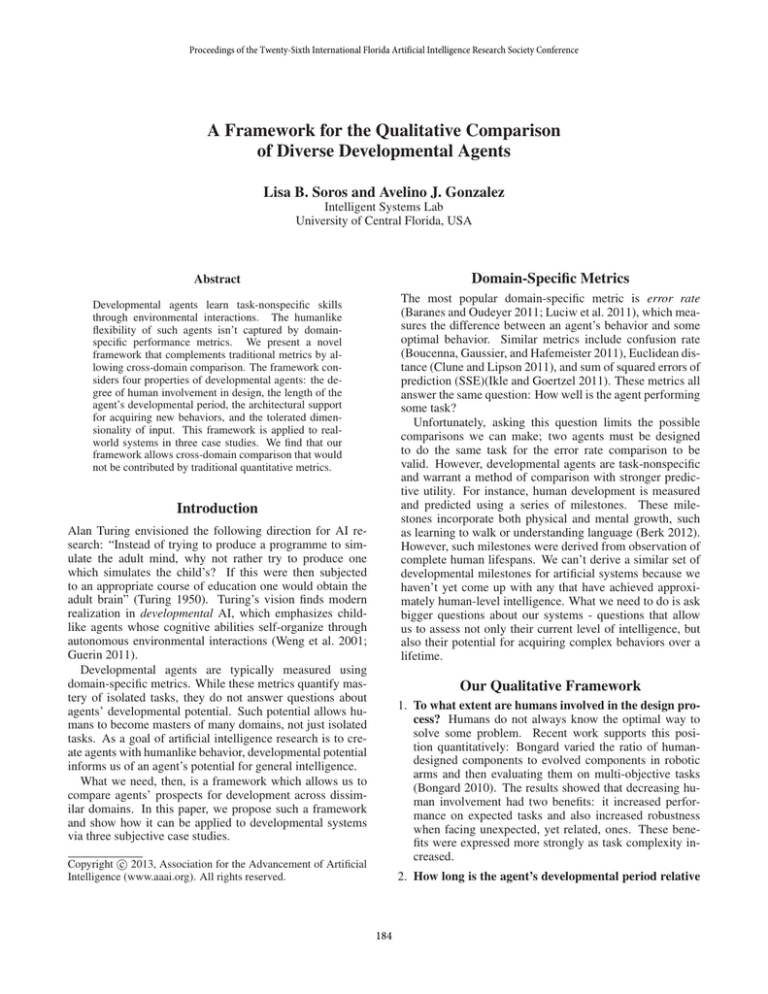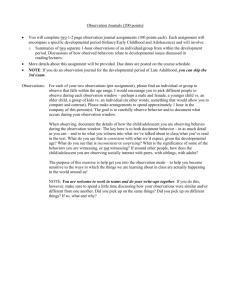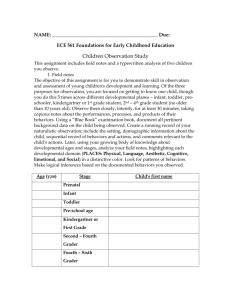
Proceedings of the Twenty-Sixth International Florida Artificial Intelligence Research Society Conference
A Framework for the Qualitative Comparison
of Diverse Developmental Agents
Lisa B. Soros and Avelino J. Gonzalez
Intelligent Systems Lab
University of Central Florida, USA
Domain-Specific Metrics
Abstract
The most popular domain-specific metric is error rate
(Baranes and Oudeyer 2011; Luciw et al. 2011), which measures the difference between an agent’s behavior and some
optimal behavior. Similar metrics include confusion rate
(Boucenna, Gaussier, and Hafemeister 2011), Euclidean distance (Clune and Lipson 2011), and sum of squared errors of
prediction (SSE)(Ikle and Goertzel 2011). These metrics all
answer the same question: How well is the agent performing
some task?
Unfortunately, asking this question limits the possible
comparisons we can make; two agents must be designed
to do the same task for the error rate comparison to be
valid. However, developmental agents are task-nonspecific
and warrant a method of comparison with stronger predictive utility. For instance, human development is measured
and predicted using a series of milestones. These milestones incorporate both physical and mental growth, such
as learning to walk or understanding language (Berk 2012).
However, such milestones were derived from observation of
complete human lifespans. We can’t derive a similar set of
developmental milestones for artificial systems because we
haven’t yet come up with any that have achieved approximately human-level intelligence. What we need to do is ask
bigger questions about our systems - questions that allow
us to assess not only their current level of intelligence, but
also their potential for acquiring complex behaviors over a
lifetime.
Developmental agents learn task-nonspecific skills
through environmental interactions. The humanlike
flexibility of such agents isn’t captured by domainspecific performance metrics. We present a novel
framework that complements traditional metrics by allowing cross-domain comparison. The framework considers four properties of developmental agents: the degree of human involvement in design, the length of the
agent’s developmental period, the architectural support
for acquiring new behaviors, and the tolerated dimensionality of input. This framework is applied to realworld systems in three case studies. We find that our
framework allows cross-domain comparison that would
not be contributed by traditional quantitative metrics.
Introduction
Alan Turing envisioned the following direction for AI research: “Instead of trying to produce a programme to simulate the adult mind, why not rather try to produce one
which simulates the child’s? If this were then subjected
to an appropriate course of education one would obtain the
adult brain” (Turing 1950). Turing’s vision finds modern
realization in developmental AI, which emphasizes childlike agents whose cognitive abilities self-organize through
autonomous environmental interactions (Weng et al. 2001;
Guerin 2011).
Developmental agents are typically measured using
domain-specific metrics. While these metrics quantify mastery of isolated tasks, they do not answer questions about
agents’ developmental potential. Such potential allows humans to become masters of many domains, not just isolated
tasks. As a goal of artificial intelligence research is to create agents with humanlike behavior, developmental potential
informs us of an agent’s potential for general intelligence.
What we need, then, is a framework which allows us to
compare agents’ prospects for development across dissimilar domains. In this paper, we propose such a framework
and show how it can be applied to developmental systems
via three subjective case studies.
Our Qualitative Framework
1. To what extent are humans involved in the design process? Humans do not always know the optimal way to
solve some problem. Recent work supports this position quantitatively: Bongard varied the ratio of humandesigned components to evolved components in robotic
arms and then evaluating them on multi-objective tasks
(Bongard 2010). The results showed that decreasing human involvement had two benefits: it increased performance on expected tasks and also increased robustness
when facing unexpected, yet related, ones. These benefits were expressed more strongly as task complexity increased.
c 2013, Association for the Advancement of Artificial
Copyright Intelligence (www.aaai.org). All rights reserved.
2. How long is the agent’s developmental period relative
184
to its lifespan? Things change all the time. It is not always easy to predict the ways in which things will change;
changes frequently occur before we can formulate plans
to deal with them. Robustness in the face of such change
requires the capacity to change oneself in response to external conditions. Such change is impossible if an agent’s
behavior becomes fixed after a limited developmental period. Thus, the length of an agent’s developmental period
gives insight about the agent’s ability to adapt.
Q(st , at ) ← Q(st , at ) + α[rt + γQ(st+1 , at+1 )
−Q(st , at )]
The agent combines SARSA with LSPI (Lagoudakis
and Parr 2003) to construct a Markov decision process
from environmental samples. These samples take the form
(s, a, r, a0 ), denoting initial state s, executed action a, resulting reward r, and successive state s0 . Using the model built
from such samples, the agent iteratively improves its behavioral policy until it exceeds some acceptability threshold.
3. To what extent does the system’s architecture allow
the acquisition of new behaviors? Adaptation is critical to general intelligence, so we must critically analyze
an agent’s structure in order to accurately assess its ability to innovate. For instance, an agent that chooses from
a fixed set of actions is constrained in the number of new
behaviors it could display. A more flexible architecture,
such as one that utilizes bootstrapping, would be more effective. This property is difficult to evaluate quantitatively
in a comparative setting, but that it is critical to dynamic
adaptivity (Raibulet and Masciadri 2009).
Case Study 2 (CS2) The second system is a robotic head
that develops joint attention and social referencing skills via
interactions with a human caregiver (Boucenna, Gaussier,
and Hafemeister 2011). The human-robot interactions proceeds in three phases. In the first phase, the robot learns to
recognize and imitate the human’s facial expressions. It randomly selects and displays a pre-programmed expression,
which the caregiver mimics (thus triggering an associative
mechanism within the robot’s neural network). In the second phase, the robot learns to recognize what the human
caregiver is looking at and direct its gaze at the same object.
This proceeds in a similar manner as the first phase, with the
robot and human taking turns imitating each other. In the
final phase, the robot combines its newly-acquired skills to
learn to follow the human’s gaze, recognize the subject of
the caregiver’s attention, perceive the caregiver’s displayed
emotion, and associate that emotion with the object of attention. This process is a form of bootstrapping, in which
simple behaviors are used to build more complex ones.
This system is noteworthy because the social referencing
skills emerge from a simple sensorimotor architecture. This
architecture is largely composed of a neural network, which
is further composed of specialized sub-networks.
4. What dimensionality of input is tolerated? It is apparent that complex human behaviors rely on rich internal
representations (Oudeyer 2010; Steels 2003). In order for
these representations to have depth, they must be derived
from detailed sensory data. An artificial developmental
agent should similarly exploit highly dimensional sensory
data. It is not expected that the agent would retain all
of this detail in its mental representations; it is advantageous (and perhaps necessary, for the sake of computational tractability) for the agent to compress perceptual
observations. However, assessing the dimensionality of
the raw sensory data gives us a feel for the types of representations that the agent can create (and thus, its potential
for executing complex behaviors).
Case Studies
Architecture Descriptions
Case Study 3 (CS3) The third case study examines R-IAC
(Baranes and Oudeyer 2011), an intrinsically motivated developmental robot that chooses actions to maximize learning
of its sensory and sensorimotor spaces (Fig. 2). That is, it
learns the control parameters for its robotic limbs in order to
effectively explore its task environment.
The R-IAC algorithm proceeds as follows: first, the Action Selection Machine probabilistically chooses an action
to execute based on the current sensory context. The Prediction Machine then calculates the expected consequences
of this action. Next, the actual consequences are observed
in the environment. The Prediction Machine takes the difference between the expected and actual consequences and
thus computes the prediction error. It then updates itself according to the sensorimotor context and the actual, measured
consequence. The Split Machine uses the error, the sensorimotor context, and the measured consequence in order to
update the internal region tree. Finally, the Prediction Analysis Machine updates its evaluation of the learning progress
for the regions covering the sensorimotor context and measured consequence.
Case Study 1 (CS1) The first system is a curiosity-based
reinforcement learning (RL) agent that learns to navigate an
initially unknown maze (Luciw et al. 2011). The agent has
a noisy birds-eye view of itself and must repeatedly choose
to move one square up, down, left, or right until it reaches
a marked goal. The system architecture (Fig. 1) has three
major components: 1) a manually-parameterized perceptual
system that compresses and encodes sensory observations
as states; 2) a cognitive system that calculates transitions
between perceptual states and potential rewards; and 3) a
value system that uses RL methods to formulate a policy
based on the expected future discounted rewards.
The first RL method is SARSA (Rummery and Niranjan
1994). SARSA is a state-based RL algorithm for learning
a Markov decision process. At each time step, the agent
uses its current state to update its Q-value estimate for its
available state-action pairs. This update is based on a discount factor (γ), which determines the significance of future
rewards, and a manually-specified learning rate (α). The expression for the SARSA update at time t is as follows:
185
Figure 1: Architecture of Case Study 1, from (Luciw et al. 2011)
Figure 2: Architecture of Case Study 3, from (Baranes and Oudeyer 2011)
Application of Framework
How long is the agent’s developmental period relative to
its lifespan? The perceptual, cognitive, and value maps in
CS1 update throughout the agent’s lifespan. This causes the
agent to be continually trying to find a new place to explore
and thus satisfy its curiosity drive.
CS2’s skills develop via training periods of interaction
with a human. There are distinct phases during which the
neural network is either learning or not learning. So, though
an arbitrarily large number of training/acting phase pairs
could occur during the lifetime, we cannot count the nontraining time as belonging to a developmental period.
CS3 learns continually as long as it has new sensorimotor
space to explore. Given a sufficiently rich environment, the
developmental period might extend throughout the agent’s
lifetime. There may, however, be a limitation imposed on
the system by its internal region tree (the explored sensorimotor space’s representation) when the dimensionality of
the sensorimotor space grows exponentially.
To what extent are humans involved in the design process? Though CS1’s behavioral policies are automatically
generated, execution relies on manually-specified parameters, including error averaging rates, initial long-term error,
learning rate lower bound, future reward discount factor, and
number of steps between LSPI planning phases.
Humans are only really involved in the high-level design
of CS2. This is because CS2 relies on neural networks as its
base. While humans may have influence over the structure
of the networks, they are certainly not determining the finegrained details such as connection weights.
The design of CS3 allows for different modules to be incorporated (i.e., the original authors are agnostic about the
algorithm behind the prediction learning machine). However, the designers manually specify the three strategies that
the agent uses for exploration, in addition to the probabilities
that the agent will pick each of the strategies.
186
To what extent does the system’s architecture allow the
acquisition of new behaviors? CS1 is limited; its intrinsic motivation system allows it to self-generate new policies,
but, it is incapable of generating new actions. Since the possible actions are manually specified during the design process, a human would have to reprogram the system for it to
acquire new behaviors.
CS2 learns new behaviors via its interactions with its
caregiver using a vision-based mechanism. However, this
mechanism could easily extend beyond vision as it is implemented using a generic neural network. Additionally,
the system’s bootstrapping mechanism allows it to not only
learn new simple behaviors, but to combine its existing behaviors into new, more complex ones.
The algorithm underlying CS3 was intentionally written
to generalize. In fact, the reason that the agent learns the
skills that it does in the original experiment is because of the
particular sensory capabilities of the simulated robot. Thus,
the generality of the architecture of the developmental system itself lends itself to the acquisition of new behaviors
- however, it must be incorporated into an agent with adequately informative sensors.
No system is comprehensively best; each has strengths
and weaknesses. Future work will consider more case studies and investigate deeper architectural features.
References
Baranes, A., and Oudeyer, P.-Y. 2011. The interaction of
maturational constraints and intrinsic motivations in active
motor development. In Proceedings of the 2011 IEEE Conference on Development and Learning (ICDL), volume 2.
Berk, L. E. 2012. Infants and Children: Prenatal through
middle childhood. Pearson.
Bongard, J. 2010. The utility of evolving simulated robot
morphology increases with task complexity for object manipulation. Artificial Life XI.
Boucenna, S.; Gaussier, P.; and Hafemeister, L. 2011. Development of joint attention and social referencing. In Proceedings of the 2011 IEEE Conference on Development and
Learning (ICDL), volume 2.
Clune, J., and Lipson, H. 2011. Evolving three-dimensional
objects with a generative encoding inspired by developmental biology. ACM SIGEVOlution 5(4):2–12.
Guerin, F. 2011. Learning like a baby: A survey of artificial intelligence approaches. The Knowledge Engineering
Review 26(2):209–236.
Ikle, M., and Goertzel, B. 2011. Nonlinear-dynamical attention allocation via information geometry. In Artificial
General Intelligence, volume 6830/2011 of Lecture Notes
in Computer Science. 62–71.
Lagoudakis, M. G., and Parr, R. 2003. Least-squares policy
iteration. Journal of Machine Learning Research 4:1107–
1149.
Luciw, M.; Graziano, V.; Ring, M.; and Schmidhuber, J.
2011. Artificial curiosity with planning for autonomous
perceptual and cognitive development. In Proceedings of
the 2011 IEEE Conference on Development and Learning
(ICDL), volume 2.
Oudeyer, P.-Y. 2010. On the impact of robotics in behavioral
and cognitive sciences: from insect navigation to human
cognitive development. IEEE Transactions on Autonomous
Mental Development 2(1):2–16.
Raibulet, C., and Masciadri, L. 2009. Evaluation of dynamic adaptivity through metrics: an achievable target? In
Proceedings of the 4th International Conference on Software
Engineering Advances, 341–344. IEEE.
Rummery, G. A., and Niranjan, M. 1994. On-line q-learning
using connectionist systems. Technical report, Cambridge
University.
Steels, L. 2003. Intelligence with representation. Philosophical Transactions of the Royal Society A 361(1811):2381–
2395.
Turing, A. 1950. Computing machinery and intelligence.
Mind LIX(236):433–460.
Weng, J.; McClelland, J.; Pentland, A.; Sporns, O.; Stockman, I.; Sur, M.; and Thelen, E. 2001. Autonomous
mental development by robots and animals.
Science
291(5504):599–600.
What dimensionality of input is tolerated? CS1 tolerates high-dimensional visual data and handles noise well
when creating internal representations. Though the described implementation was only simulated, the system’s focus on sensory data compression would allow performance
to scale well with increased dimensionality and noise.
CS2 also tolerates fairly high-dimensional visual input;
its robotic eyes perform online facial recognition and can
follow a human’s gaze. However, the agent doesn’t learn
to recognize faces on its own; the skill is pre-programmed.
Thus, the system’s ability to tolerate one type of raw input
does not necessarily extend to other dimensions.
Like CS1 and CS2, CS3 operates on real-world visual
data. However, its sensory/state channels are designed
to accommodate arbitrary types of input (the creators cite
torque motor values and touch sensor values as examples).
They can also interpret feedback from higher-level cognitive
mechanisms.
Discussion
• Both CS1 and CS3 rely on human-specified parameters
(with CS1 doing so to a greater extent than CS3). CS3 is
better than both of its competitors in this regard because
the relevant parameters are learned over time.
• CS2 has the smallest development-to-lifespan ratio. CS1
and CS3 were approximately equal in this regard, with
CS1 showing slightly greater ability for maintaining the
developmental period over an arbitrarily long lifespan.
• CS1 in its current format does not support novel behaviors. CS2 and CS3 rely on fairly general algorithms, and
show more potential for development in this regard.
• Of the three systems, CS3 leads the pack in terms of displayed potential for tolerating input with arbitrarily high
dimensions. CS1 comes in second place, followed by
CS2.
187






